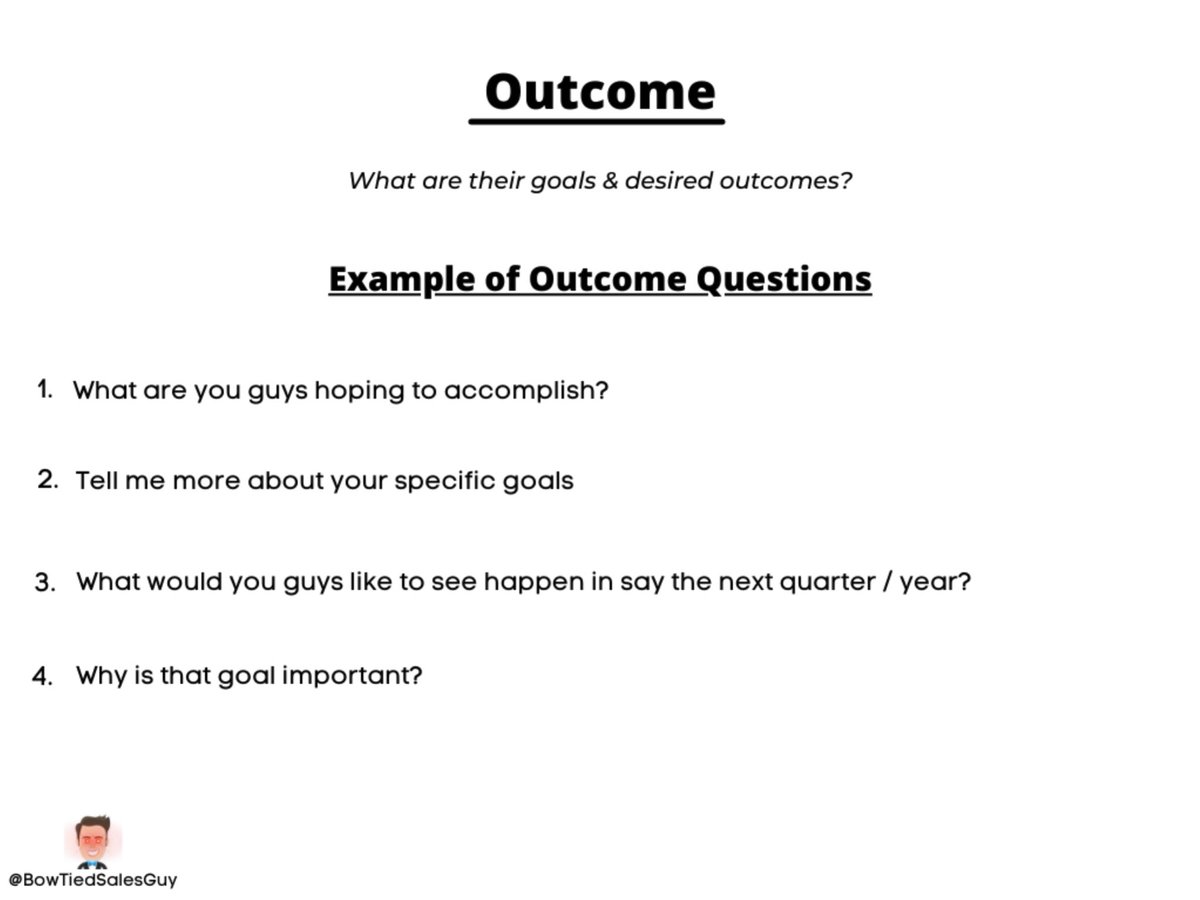“Chad, how do I ask the right questions in the right order in order to win the deal?”
Good question!
Here is my Chad Questioning Framework
🤑 See which questions are the right ones to ask
🤡 and see which questions NOT to ask
A crash course (thread) 👇🏼
Good question!
Here is my Chad Questioning Framework
🤑 See which questions are the right ones to ask
🤡 and see which questions NOT to ask
A crash course (thread) 👇🏼

So in order to fully understand what a Chad questioning framework looks like, we need to first look at what a 🤡 does!
Introducing, the 🤡’s Questions:
Introducing, the 🤡’s Questions:

These questions are terrible for a few reasons:
1) Shows incompetence (the opposite of a Competent Chad Salesman)
2) Only goes surface level in regards to the Prospects Pain
3) In a rush to show the product
4) “Do you want a proposal?” Proposals are deal killers. Few.
1) Shows incompetence (the opposite of a Competent Chad Salesman)
2) Only goes surface level in regards to the Prospects Pain
3) In a rush to show the product
4) “Do you want a proposal?” Proposals are deal killers. Few.
Let’s thank the 🤡 for his mistakes so we know what NOT to do!
Thank you 🤡!
Now off you go!
Thank you 🤡!
Now off you go!
So how does a Chad approach asking questions in the sales process?
First off he uses a Framework, or a blueprint if you will.
This Framework isn’t set in stone but rather serves as a North Star guiding Chad to the gold (Bitcoin)
This is the Framework:
First off he uses a Framework, or a blueprint if you will.
This Framework isn’t set in stone but rather serves as a North Star guiding Chad to the gold (Bitcoin)
This is the Framework:

When you’re in the heat of the moment, this framework will act as your guide to make sure you stay on the narrow path forward towards the desired outcome (closed deal)
Now let’s dive into each section.
Now let’s dive into each section.
1) Facts
These are surface level questions but important in order to get missing info / specific details
The money is in those specific details anon.
These questions are more “rapid fire” in nature (easy answers)
Don’t ask questions that can easily be found on Linkedin, etc
These are surface level questions but important in order to get missing info / specific details
The money is in those specific details anon.
These questions are more “rapid fire” in nature (easy answers)
Don’t ask questions that can easily be found on Linkedin, etc

2) Process
This is where they will explain their internal processes and where you will be able to pinpoint the inefficiencies (they will almost always talk about challenges here. Note them)
This part builds momentum & provides context for the next section
This is where they will explain their internal processes and where you will be able to pinpoint the inefficiencies (they will almost always talk about challenges here. Note them)
This part builds momentum & provides context for the next section

3) Pain
My favorite part. This is where the deals get closed.
Anon, you must dig, Dig, DIG!
Explore all the emotional elements on the left side with them
Go DEEP!
My favorite part. This is where the deals get closed.
Anon, you must dig, Dig, DIG!
Explore all the emotional elements on the left side with them
Go DEEP!

4) Budget
This is self explanatory. Talk about Money
Many salespeople feel shame talking about money. Get rid of that now and talk about it with them.
It’s important.
This is self explanatory. Talk about Money
Many salespeople feel shame talking about money. Get rid of that now and talk about it with them.
It’s important.

5) Decision
When selling to enterprise you usually have many stakeholders (6~10 according to Gartner)
You have to understand how decisions are made and how products are bought in your prospects company
If you sell to < 150 person company then this part might be overkill
When selling to enterprise you usually have many stakeholders (6~10 according to Gartner)
You have to understand how decisions are made and how products are bought in your prospects company
If you sell to < 150 person company then this part might be overkill

Forgot to include Outcome
The Outcome is centered around what they want the Future to look like.
Talking about Outcomes after Pain is near perfect sequencing
Pain (Fear, Hopeless, Negative)
Outcome (Hope, Desire, Positive)
The Outcome is centered around what they want the Future to look like.
Talking about Outcomes after Pain is near perfect sequencing
Pain (Fear, Hopeless, Negative)
Outcome (Hope, Desire, Positive)

• • •
Missing some Tweet in this thread? You can try to
force a refresh











